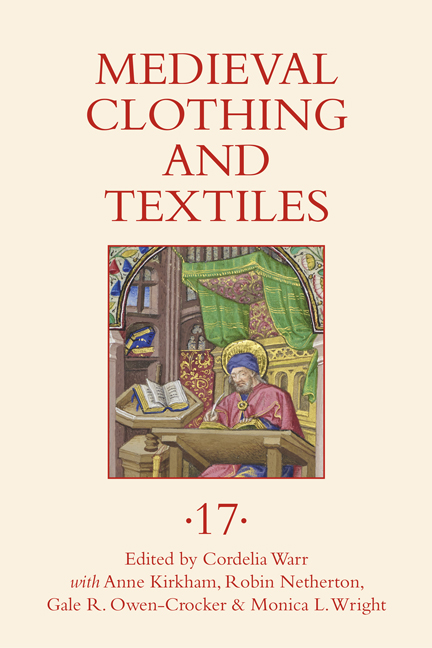Book contents
- Frontmatter
- Contents
- Illustrations
- Tables
- Contributors
- Acknowledgements
- Preface
- 1 Embroidered Beasts: Animals in the Bayeux Tapestry
- 2 The Sleeve from Bussy-Saint-Martin: A Rare Example of Medieval Quilted Armor
- 3 The Administration of Cloth and Clothing in the Great Wardrobe of Edward I
- 4 Hanging Together: Furnishing Textiles in a Fifteenth-Century Book of Hours
- 5 Gilt-leather Embroideries from Medieval Sweden and Finland
- 6 From Hennin to Hood: An Analysis of the Evolution of the English Hood Compared to the Evolution of the French Hood
- Recent Books of Interest
- Author Index, Volumes 1–16
3 - The Administration of Cloth and Clothing in the Great Wardrobe of Edward I
Published online by Cambridge University Press: 17 December 2023
- Frontmatter
- Contents
- Illustrations
- Tables
- Contributors
- Acknowledgements
- Preface
- 1 Embroidered Beasts: Animals in the Bayeux Tapestry
- 2 The Sleeve from Bussy-Saint-Martin: A Rare Example of Medieval Quilted Armor
- 3 The Administration of Cloth and Clothing in the Great Wardrobe of Edward I
- 4 Hanging Together: Furnishing Textiles in a Fifteenth-Century Book of Hours
- 5 Gilt-leather Embroideries from Medieval Sweden and Finland
- 6 From Hennin to Hood: An Analysis of the Evolution of the English Hood Compared to the Evolution of the French Hood
- Recent Books of Interest
- Author Index, Volumes 1–16
Summary
Those interested in the material culture of the medieval English royal court are inevitably drawn into the mysterious world of the Great Wardrobe, the household department responsible for sourcing, storing, and distributing various goods, including cloth. The clerks of the Great Wardrobe kept careful records of all of these activities, many of which have survived. Such records have both their allure and their difficulties, as acknowledged in 1991 by Kay Staniland:
Medieval documentary evidence has been little explored by dress historians and yet is a rich and varied source, providing facts, details and statistics not otherwise available. True, the documents present many problems of comprehension and translation, and abound in undefined terminology, but nevertheless the factual information they provide is vital to an understanding of clothing in this period.
Over the past forty years, historians including Frédérique Lachaud, Lisa Monnas, Stella Mary Newton, Caroline Shenton, Kay Staniland, Juliet Vale, and Malcolm Vale, have demonstrated just how informative such documentation can be. The published literature is particularly strong on the period between the reigns of Henry III (1216–72) and Edward III (1327–77), of whom the latter emerges as the archetypal flamboyant prince who provided a model of magnificent sartorial kingship not surpassed until the reign of Henry VIII (1509–47).
Despite the attractions of this material, its difficulties are not inconsiderable, especially for first-time users. Fortunately, there are numerous aids that can help to alleviate many of these challenges, in particular those of palaeography and language. Printed sources are also extremely useful, especially those which transcribe and translate, such as those printed by Her Majesty's Stationery Office in the 1970s and 1980s and, more recently, collections like Medieval Dress and Textiles: A Multilingual Sourcebook. Unfortunately, the accounts of the Great Wardrobe pose another significant challenge, namely the peculiarities of the administration that produced them. The royal household was a complicated world with its own idiosyncrasies of accounting practice. Navigating its accounts can be difficult. They often seem to overlap and interact in their content, but not always in obvious ways.
- Type
- Chapter
- Information
- Medieval Clothing and Textiles 17 , pp. 67 - 90Publisher: Boydell & BrewerPrint publication year: 2023



